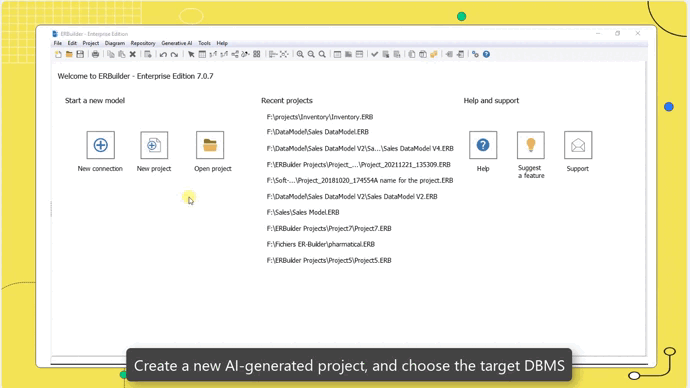Data Modeling with Generative AI: The Future is Now
Apr 27 , 2024
In recent years, the advent of generative AI has transformed numerous fields, with data modeling being no exception. This innovative technology has the potential to automate and enhance various stages of the data modeling process, from conceptualization to physical implementation. This post explores how generative AI can be integrated into the data modeling journey, providing examples and discussing the groundbreaking integration of ChatGPT AI with ERBuilder (a desktop data modeling tool) to generate Entity Relationship Diagrams (ERDs).
Generative AI in Data Modeling
Generative AI refers to algorithms capable of creating content, from text to images and code, based on the patterns and information they have learned. In data modeling, this capability can streamline the creation of data models, automate repetitive tasks, and even suggest optimizations based on best practices.
Examples of Generative AI in Data Modeling
- Automated Schema Generation: AI can analyze existing data structures and generate schema recommendations, speeding up the initial phases of database design.
- Optimization Suggestions: By understanding the relationships and usage patterns within a database, AI can suggest indexing strategies or modifications to improve performance.
- Natural Language Processing (NLP) to ERD Translation: Using NLP, generative AI can translate plain English descriptions of data requirements directly into complex ERDs, reducing the barrier to entry for non-technical stakeholders.
Case Study: ERBuilder Integrates ChatGPT for ERD Generation
A notable example of generative AI in action is ERBuilder's integration of ChatGPT AI. This collaboration allows users to input descriptions of their data model in natural language, from which ERBuilder use ChatGPT capabilities to generates accurate and detailed ERDs.
This not only speeds up the modeling process but also ensures that the diagrams are reflective of user intentions, even if the user lacks deep technical expertise in data modeling.
Benefits of Using Generative AI in Data Modeling
- Increased Efficiency: AI reduces the time required to create and revise data models.
- Enhanced Accuracy: AI algorithms can minimize human errors and ensure that data models align with business requirements.
- Scalability: AI can handle increasing amounts of data and more complex models without a corresponding increase in human effort.
The integration of generative AI into data modeling tools like ERBuilder is just the beginning. As these technologies continue to evolve, they promise to further democratize data modeling, making it more accessible and effective. The potential for AI to not only support but enhance the data architect's role is immense, paving the way for more innovative and efficient solutions in database design.
How ERBuilder Helps
ERBuilder is a GUI data modeling tool that allows you to visualize, design, and model databases by using entity relationship diagrams and automatically generates the most popular SQL databases. Generate and share the data Model documentation with your team. Optimize your data model by using advanced features such as test data generation, schema comparison, and schema synchronization.







